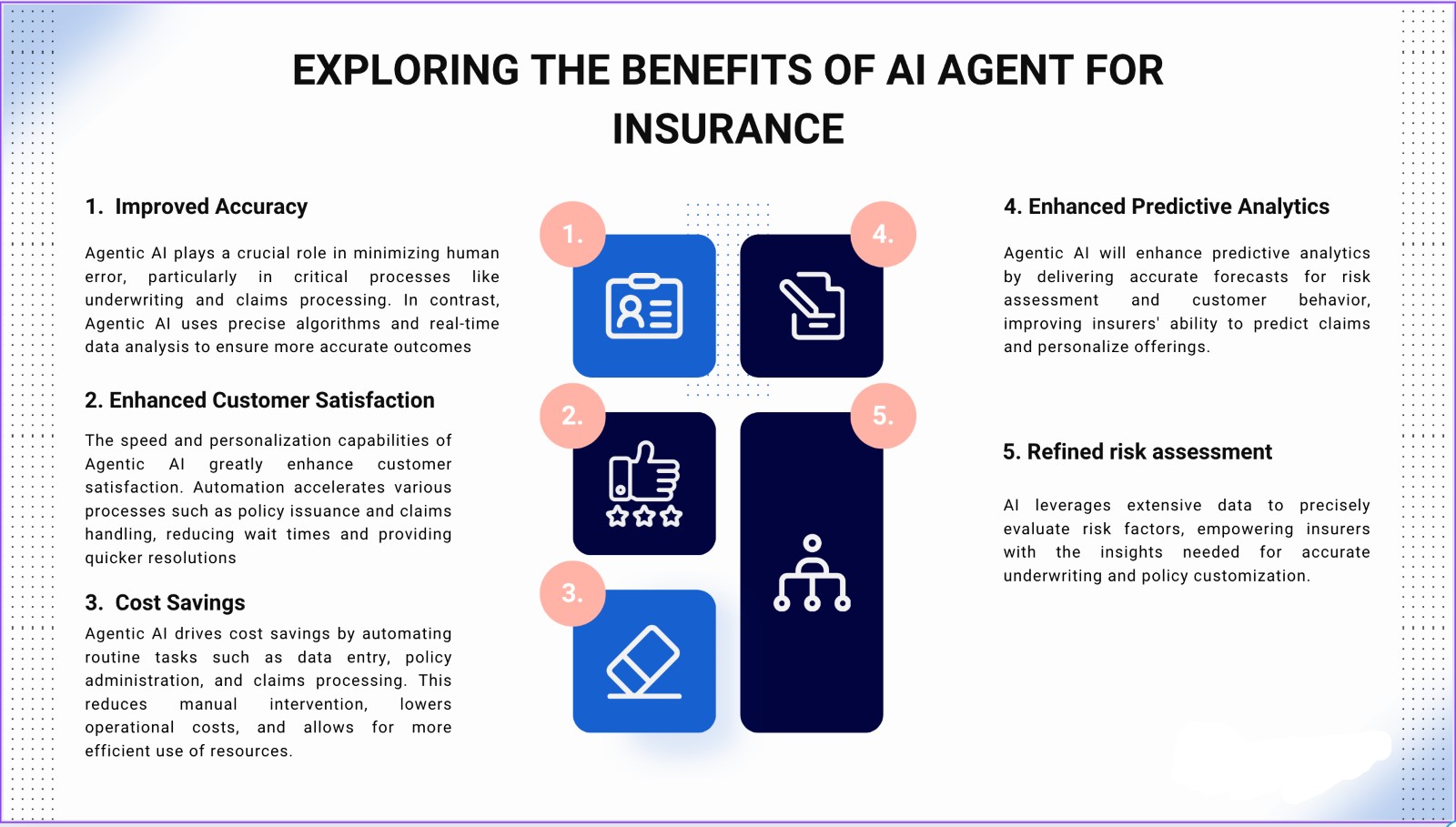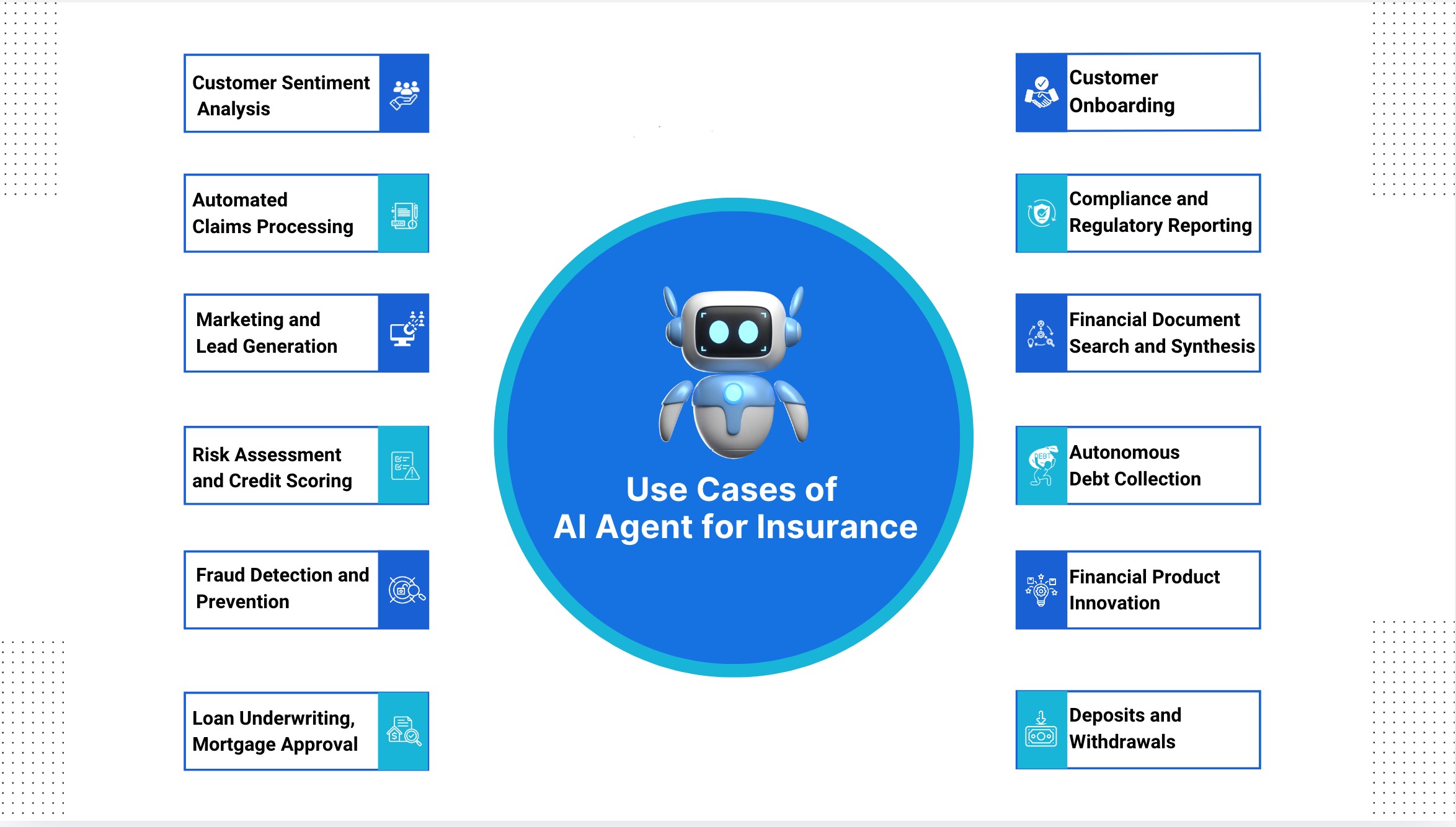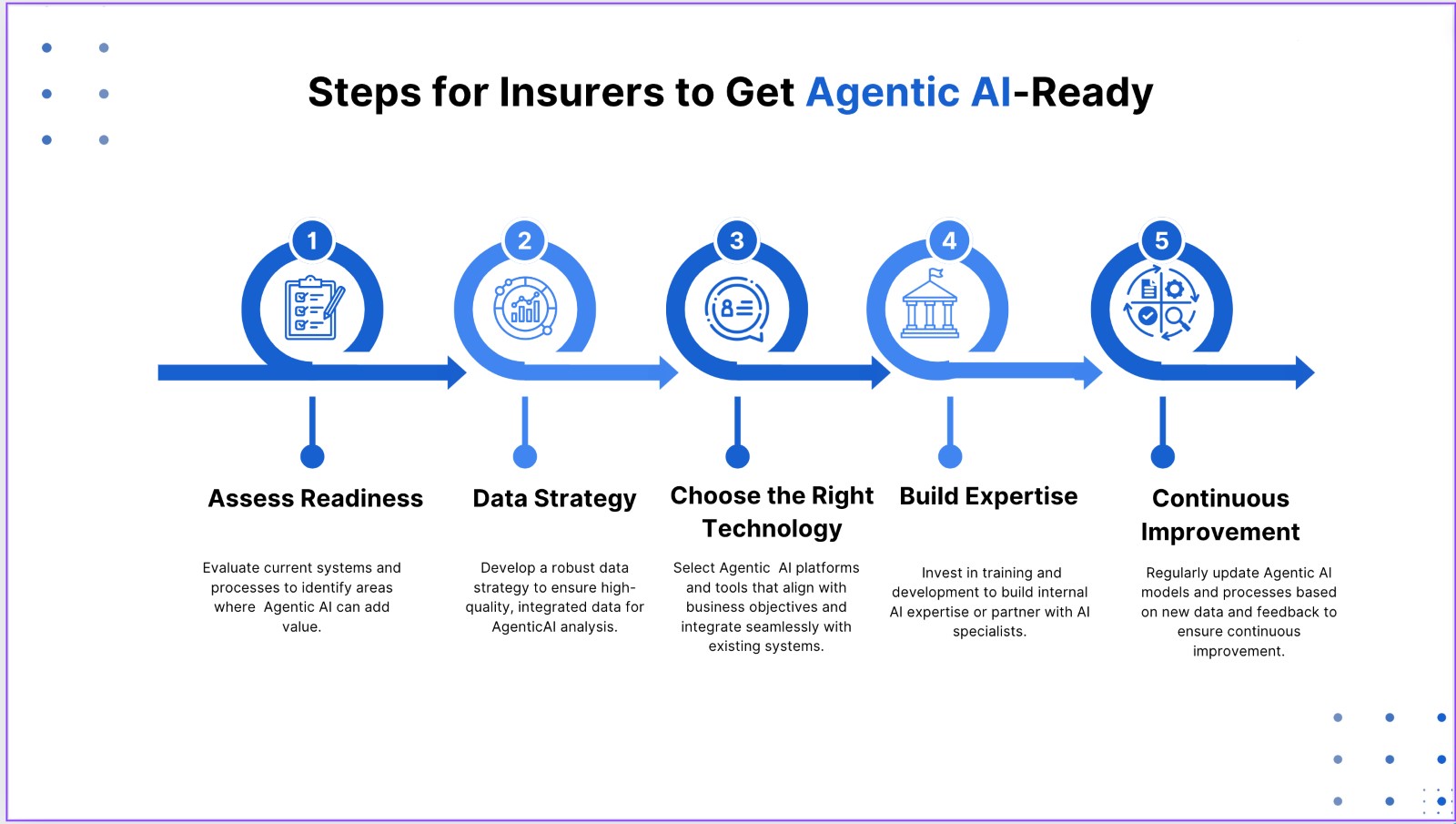Agentic Insurance Agent, powered by Agentic AI, autonomously engages with policyholders, answering questions and handling objections while booking meetings for human agents. Through agentic workflow, the Agentic Claims Adjuster Agent streamlines claims processing, identifying fraud, and managing routine cases, enabling insurers to focus on complex scenarios and improve overall efficiency.
Insurance relies heavily on data and risk assessment for key functions like underwriting, claims processing, and customer service. In traditional methods, managing the increasing volume and complexity of data from sources like customer information, claim histories, social media, and IoT devices, results in inefficiencies and delays, slow service, generic policy offerings, and frustrated customers. It hampers risk assessment and pricing accuracy, limiting innovation and the industry’s ability to meet modern customer expectations.
Understanding the Need for Agentic AI in Insurance
The insurance industry faces significant challenges, including information overload, rising customer expectations, and the complexities of modern risk management. Insurers are inundated with vast amounts of data from various sources, making it increasingly difficult to extract valuable insights using traditional methods. This data deluge hampers their ability to respond to the personalized needs of customers, who now demand faster and more tailored services. Additionally, conventional risk models often fail to capture the intricacies of today’s dynamic business environment, leaving insurers struggling to manage emerging risks effectively. The labor-intensive processes prevalent in the industry further exacerbate inefficiencies, diverting resources away from more productive initiatives.
In this context, agentic AI presents a compelling solution. Employing advanced algorithms and machine learning enables insurers to analyze data more efficiently, predict outcomes, and automate decision-making processes. This technology streamlines operations and enhances customer experiences by providing tailored offerings and faster responses. Furthermore, it improves risk assessment capabilities, allowing insurers to model complex scenarios and proactively mitigate potential threats. Ultimately, the integration of this multi-agent system into the insurance landscape transforms how insurers operate, making them more agile, responsive, and capable of meeting the demands of a rapidly evolving market.
How Does Agentic AI Transform Insurance for Insurers and Consumers?
Agentic AI is shifting the character of data processing and machine learning capabilities in the insurance industry for both sides: insurers and customers. From such enhanced operations and hence improved decision-making on its side, insurers can then upgrade to a better customer experience.
Transformation for Insurers
- Improve Risk Assessment: The multi-agent system will take real-time data from all sources, analyze, and identify trends and patterns, enabling precise risk profiling, underwriting, and pricing.
- Operational Efficiency: Automation of routine work like claim processing and policy administration reduces human errors and processes speed up so the staff can focus more jobs that are complex.
- Detect frauds: AI models detect anomalies and suspicious patterns potentially indicative of fraud, minimizing financial losses by alerting potentially fraudulent claims to further investigation.
- Data consolidation: This system can combine different data sources to provide complete views of each customer and risk profile, making decisions much more informed.
Transformation for Consumers
- Tailor-made Policies: AI-driven insights enable insurers to offer customized policies based on individual risk profiles and preferences, ensuring relevant coverage at competitive prices.
- Rapid Claims Processing: Automation basically simplifies the claims process, from submission to settlement, thus increasing customer satisfaction due to more rapid resolution.
- Improving the Experience: AI-powered chatbots and virtual assistants ensure an available round-the-clock support system for customers, answering queries and executing policy management to provide on-time and accurate support.
- Pro-Active Services: Predictive analytics can anticipate their needs, thus providing proactive solutions such as policy renewals and coverage adjustments thereby enhancing customer satisfaction and retention.
How Does Agentic AI for Insurance Work?
Agentic AI innovates insurance businesses with high technologies to develop optimization in data handling and decision-making processes for continuous improvement. This is done this way:
1. Data Collection and Integration
This multi-agent system starts with gathering data from a diverse array of sources. This includes:
- a) Customer Interactions: Information from various touch points such as policy purchases, claims submissions, and customer feedback.
- b) Social media: Customer posts and reviews on any platform such as Twitter or Facebook can give any amount of sentiment and trend data.
- c) IoT Devices: Real-time information and action analytics regarding automobile telematics and health tracking devices to truly ask what the customer is doing and in what condition.
- d) Historical Records: Past records including previous claims, policy details, and underwriting information.
Once collected, this data is integrated into a centralized system. Integration involves consolidating disparate data streams into a unified format, allowing for a comprehensive view that facilitates more effective analysis.
2. Data Analysis and Pattern Recognition
With data integrated, Agentic AI employs machine learning algorithms to perform in-depth analyses. This process includes:
- a) Pattern Recognition: This system identifies recurring trends and relationships within the data. For example, it may single out patterns in claim submissions that indicate common types of fraud or recognize behaviors that correlate with higher risk.
- b) Behavioral Insights: The behavior of customers towards the insurance services can help analyze the individual needs and preferences thus helping in the provision of more customized services or offers.
- c) Risk Prediction: By analyzing and comparing historical records with the current records, AI can predict probable risks and their possibilities in future claims or losses.
In addition, AI identifies anomalies-rare or unusual patterns that would signal fraud or other issues. For instance, if the details of a claim are quite vastly deviating from historical data, such a claim may be flagged and lead to investigation.
3. Decision Making and Automation
Insights derived from data analysis are used to streamline and automate decision-making processes, such as:
- a) Claims Processing: AI can evaluate claims by verifying details against existing data and predefined criteria. For instance, it might automatically approve or deny a claim based on damage assessments and historical patterns.
- b) Policy Issuance: AI automates underwriting by assessing risk profiles and determining appropriate policy terms and pricing without human intervention.
4. Continuous Learning and Improvement
Agentic AI evolves with new data and experiences. This involves:
- a) Model Refinement: Regular updates to algorithms based on new data improve their accuracy and effectiveness. For instance, the model can be updated to predict the risk much more accurately in new emerging trends or even kinds of data.
- b) Performance Monitoring: AI systems are tested at intervals to ensure they work correctly. This monitoring helps identify areas for improvement and adjust models accordingly.
This continuous learning ensures that, even in the presence of changing market conditions and evolving risks besides other shifts by customers, AI can remain relevant and operative. Thus, through learning new information, this system remains to be accurate and efficient over time.
Exploring the Benefits of AI Agents for Insurance
Agentic AI offers transformative benefits for the insurance sector by significantly enhancing accuracy, customer satisfaction, cost efficiency, and competitive positioning.

- Improved Accuracy : This multi-agent system reduces human error in underwriting and claims processing by replacing manual data entry and subjective judgment with precise algorithms and real-time data analysis. This leads to consistent risk assessment, fairer pricing, and more reliable decisions.
- Enhanced Customer Satisfaction: The system boosts customer satisfaction by accelerating policy issuance and claims handling, minimizing wait times. It personalizes insurance products through customer data analysis and employs predictive analytics for proactive engagement, such as policy renewal reminders and coverage suggestions, enhancing overall experience and loyalty.
- Cost Savings: AI agents automate routine tasks like data entry and claims processing, lowering operational costs and manual work. They speed up claims handling and enhances fraud detection, preventing losses and reducing investigation expenses.
- Enhanced Predictive Analytics: Agentic AI will advance predictive analytics by offering more precise forecasts for risk assessment and customer behavior. Through sophisticated machine learning algorithms and extensive datasets, it will enhance insurers’ ability to predict claims, identify potential risks, and personalize offerings.
Applications and Use Cases of AI Agents in Insurance

1. Customer Sentiment Analysis: These agents evaluate customer sentiment through social media and feedback analysis. This helps companies understand the preferences of their customers better, and better responses lead to better engagement.
2. Automated Claims Processing: Autonomous agents streamline the claims process by automating the tasks of verification of documents, damage assessment, and approval of a claim. It enables direct settlement faster with reduced processing costs, improved customer satisfaction, and better service since claims are resolved much quicker and more accurately.
3. Marketing and Lead Generation: The agents analyze customer data to create personalized marketing campaigns. To know the needs of a particular individual and his preferences, customized insurance products and services can be offered, thus leading to more possible conversions and better retention.
4. Risk Assessment and Credit Scoring: Analyzing the credit scoring of a policyholder against their risk profile through predictive analytics, these agents enable a deeper understanding of the factors involved in risk as well as the creditworthiness of the borrower. This helps them provide competitive and personalized insurance products finally.
5. Fraud Detection and Prevention: Such AI agents use machine algorithms for the observation and detection of fraudulent behavior. Pattern correlation and anomaly will help bring suspicious behavior to the attention of insurers, where it can be detected more effectively to even save money.
6. Loan Underwriting and Mortgage Approval: These agents process large data to assess risk and determine premiums. They incorporate data from social media, telematics, and historical claims to determine a comprehensive risk assessment, which leads to a great degree of precise and fair underwriting decisions and approvals.
7. Customer On-boarding: Such agents simplify onboarding a customer by streamlining identity verification processes, data entry, and compliance checks. This increases the speed, decreases the errors and makes the experience of bringing the new customer on board much smoother.
8. Compliance and Regulatory Reporting: Autonomous agents enhance compliance and regulatory reporting through automated collection of data and efficient report generation. Through predictive analysis, it identifies risks and frauds and keeps track on regulatory changes to keep policies updated.
9. Personalized Customer Experience: By analyzing every customer’s data individually, these agents customize and recommend policies and products as per their needs, improving customer experience in the process.
10. Investment Management: Through data automation, such agents can determine the investment preferences and risks of the customer. It enables them to manage investments and make better decisions.
11. Customer Service: These agents provide 24/7 support to the customers, which allows for personalized responses and quicker response times. This improves customer satisfaction and experience.
12. Cybersecurity and Risk Management: Autonomous agents can assess the risks and prevent fraud by identifying unusual patterns. This enables the company to isolate such incidents and prevent breaches, managing risks effectively.
13. Financial Document Search and Synthesis: Such agents enable efficient document retrieval and through analysis, can identify specific terms in search queries. This semantic understanding of search queries leads to easy cross-document synthesis and quick response times.
14. Regulatory Code Change Consultant: These agents automate the tracking and analysis of regulatory updates, providing timely alerts and impact assessments. They streamline document review by extracting key information and summarizing changes, helping organizations mitigate compliance risks effectively.
15. Debt Collection: The AI agents analyze payment patterns to identify high-risk customers and form communication strategies. They engage customers through personalized messages and reminders, improving collection rates while reducing operational costs.
16. Automation of Back-Office Operations: These agents handle data entry and transaction processing, minimizing manual tasks. This leads to a boost in efficiency, accuracy, and turnaround times while saving costs.
17. Financial Product Innovation and Design: In corporate finance, such agents streamline processes, provide accurate forecasting, and optimize costs. By analyzing historical data and modeling scenarios, they enable more strategic decision-making and better resource management.
18. Treasury Operations: The autonomous agents forecast cash flows and manage liquidity effectively, optimizing treasury functions. Automated risk assessments enable quicker decision-making. This leads to better resource allocation and financial stability.
19. Corporate Governance: AI agents effectively identify governance issues that might constitute specific non-compliance by automating compliance monitoring and risk assessments. Hence, they ascertain transparency and adherence to ever-evolving regulatory standards.
20. Deposits and Withdrawals: Such agents streamline deposits and withdrawals, improving speed and precision. Real-time monitoring minimizes errors and boosts customer trust. Banking has become more efficient for both customers and institutions.
21. Payments and Transactions: These agents analyze data to detect anomalies, which allows them to identify unusual transaction patterns and flag fraudulent payments to prevent further risk.
22. Audit and Internal Controls: By automating data analysis, enabling continuous monitoring, and improving risk assessment, these agents improve audit processes and internal controls. This proactive approach allows organizations to detect irregularities in real time and maintain compliance effectively.
23. Corporate Finance: In corporate finance, these agents streamline processes, provide accurate forecasting, and optimize costs. By analyzing historical data and modeling scenarios, they enable more strategic decision-making and better resource management.
Steps for Insurers to Get Agentic AI-Ready

1. Assess Readiness: Review existing systems and operations to clearly note how AI will add value.
2. Data Strategy: Form a solid data strategy aimed at producing high-quality, integrated datasets for AI analytics.
3.Choose the Right Technology: Pick this system platforms and tools that would help meet business objectives along with fitting them perfectly within existing systems.
4. Build Expertise: Invest in training and development or partner with AI specialists to build internal expertise.
5. Pilot Projects: Identify relevant pilot projects to pilot and hone strategies for implementing AI applications.
6. Continuous Improvement: Update the multi-agent system models and processes based on new data and feedback regularly to ensure continuous improvement.
How Does an Agentic AI Solution Power Agentic AI’s Capabilities to Empower Insurers?
Agentic AI leverages Agentic AI to significantly enhance insurers’ capabilities through several key features:
1. Advanced Analytics: It is through this analysis of such huge amounts of data that Agentic AI provides deep insights into customer behavior, risk assessment, and market trends, hence allowing insurers to make precise data-driven decisions and refine their strategies effectively.
2. Seamless Integration: The platform integrates with existing systems, ensuring little to no disruption to ongoing operations and letting insurers quickly adopt AI technologies without overhauling their infrastructure.
3. Customization: Agentic AI provides customizable solutions designed to the needs of different insurers, ensuring that the AI tools align with their specific business models and regulatory requirements.
4. Security and Compliance: With a focus on data security and regulatory compliance, Agentic AI safeguards sensitive information and helps insurers adhere to industry standards, maintaining customer trust and avoiding legal issues.
Future AI Trends in Insurance
1. Enhanced Predictive Analytics: With more precise forecasts for claims and risks, agentic AI will enhance predictive analytics for insurers. Advanced machine learning will improve how matters are priced, underwritten, and even detected with fraud.
2. Integration of Agentic AI and IoT: The fusion of this system with IoT would alter data gathering as such. Real-time information from smart devices may be used by AI/ML to customize an insurance product, monitor risk, and even automate claim processing for more responsive solutions.
3. Agentic AI-Driven Chatbots and Virtual Assistants: This multi-agent system will enable chatbots and virtual assistants to give round-the-clock support for all policy inquiries and claims processing with an appropriate and pertinent response given under agentic workflow.
4. Enhanced Fraud Detection: Advanced algorithms of agentic AI will monitor patterns and allow insurers to identify and prevent fraudulent activities. Through learning, there will be the continuous discovery of new tactics to reduce losses and increase security.
5. Evolution of Underwriting and Claims Processing: Agentic workflow will change the face of underwriting and claims processing by automating complex tasks and improving precision. It will streamline these processes, analyze large datasets efficiently, and make swift and accurate decisions.
6. Ethical AI and Data Privacy: This system raises further issues about ethics and data privacy. Its access shall be largely determined by proper use, implementation, increased security measures for customer data, and proper regulations.
Conclusion
As the insurance industry continues to transform with Agentic AI, customer service, solutions, and operational efficiency will significantly improve. This shift will allow companies to respond effectively to ever-evolving consumer demands and build trust and loyalty among policyholders. By incorporating AI agents in insurance, the insurers can stay on top of market trends while getting benefits like tailored personalization, real-time insights, swift fraud detection, and more.



